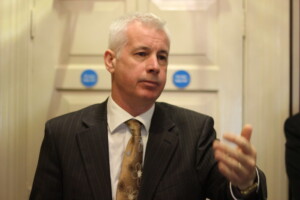Patients at Tallaght University Hospital are facing average waits of more than 12 hours to be seen in its emergency department, a delay that is five hours longer than the national average, according to new figures released by the HSE.
The numbers, which show Tallaght’s average A&E wait time at 12.6 hours compared to a statewide average of 7.3 hours, have sparked alarm and renewed criticism of the government’s handling of health services in Dublin South West.

Local Sinn Féin TD Seán Crowe (pictured above) has condemned the figures as further proof of long-standing neglect and chronic underfunding in the area, calling the situation in Tallaght “simply unacceptable”.
“Waiting times in the Tallaght University Hospital Accident and Emergency are way above the state average,” said Deputy Crowe.
“People are waiting on average 12.6 hours when the state average is 7.3 hours.”
The figures underline a stark disparity in access to emergency care, with Tallaght now logging the longest waiting times in the country, even longer than at University Hospital Limerick, which has consistently been identified as the most overcrowded hospital in the state.
“People in Tallaght are waiting two hours longer than the next highest hospital on the list,” Crowe said.
“They’re even waiting longer than in Limerick Hospital. It is simply unacceptable.”
While the figures have raised serious concerns, Crowe was careful to emphasise that responsibility does not lie with frontline staff at the hospital.
“The healthcare professionals in TUH do sterling work,” he said, “but they are being put in impossible circumstances by this government’s mismanagement of the health service.”
For Crowe, the long delays reflect more than just local bottlenecks, they are part of a broader pattern of deprivation that has left Dublin South West under-resourced across multiple public sectors.
“Dublin South West has always been chronically deprived when it comes to funding and resources for our public services,” he said. “And this is only further proof.”
In response to the crisis, Crowe is calling for a substantial increase in support for Tallaght University Hospital, along with urgent progress on infrastructure projects that have long been on the table.
Chief among his demands is the fast-tracking of a new stepdown unit, which he says is vital for relieving pressure on emergency services by opening up badly needed bed space.
“We need to see the new stepdown unit prioritised so that we can get vitally needed beds into the system,” said Crowe.
He also called for the abolition of the government’s Pay and Numbers Strategy, which restricts staffing levels in the public sector.
According to Crowe, this policy is directly limiting the hospital’s ability to recruit the nurses, doctors, and support staff it needs.
“We need the Pay and Numbers strategy done away with so that we can staff the hospital to the level that workers and their patients need,” he said.
Crowe’s intervention is likely to add momentum to calls for healthcare reform in the area, which have grown louder in recent years.
The delay in A&E care comes as residents continue to face waiting lists for diagnostics, surgeries, and specialist appointments, compounding frustration in communities that feel left behind.
Though Tallaght University Hospital is one of the country’s busiest, its resources have not kept pace with demand, and efforts to address these pressures have repeatedly stalled.
With the Department of Health yet to outline any targeted support plan for the hospital, the newly released data is likely to add fuel to the fire.
The figures also raise questions for the Health Service Executive, which has come under increasing scrutiny for regional disparities in care and wait times.
While national efforts to recruit healthcare staff continue, many hospitals — particularly in urban areas with high demand, are still struggling to meet basic patient needs.
“This isn’t about statistics,” Crowe said.
“This is about people waiting over 12 hours in pain or distress, sometimes in overcrowded waiting rooms, often with no clear idea when they’ll be seen.
“That’s the reality behind the numbers — and it’s not good enough.”
With summer months approaching, often a period of high pressure for hospitals, local residents, patients, and public representatives will be watching closely to see whether meaningful change is on the way, or whether Dublin South West will once again be left waiting.